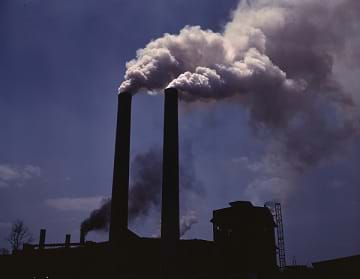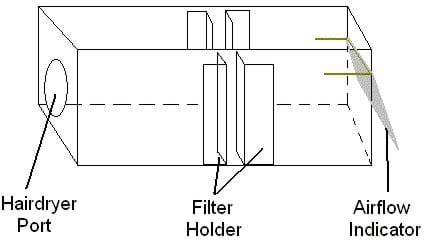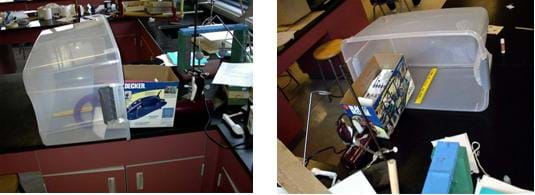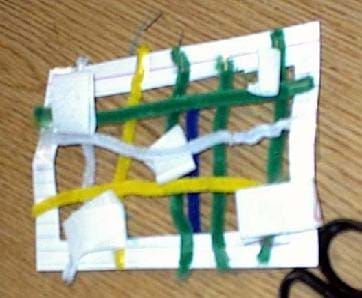Summary
Engineers design methods of removing particulate matter from industrial sources to minimize negative effects of air pollution. In this activity, students undertake a similar engineering challenge as they design and build a filter to remove pepper from an air stream without blocking more than 50% of the air.
Engineering Connection
One of the biggest challenges engineers face is devising new techniques to prevent industrial air pollution. Engineers are creative in designing modern pollutant recovery methods and industrial technologies that remove particulate matter from industrial sources to minimize negative effects of air pollution. Mechanical and environmental engineers develop new technologies to control the problems old technologies have created. For example, engineers create air filtration systems that are commonly used in homes and businesses.
Learning Objectives
After this activity, students should be able to:
- Describe several causes and health effects of air pollution.
- Use the engineering design process to create a model indoor air filter.
- Count and calculate the average number of particles collected in one area.
- Understand how engineers construct air filters to clean air pollution.
Educational Standards
Each TeachEngineering lesson or activity is correlated to one or more K-12 science,
technology, engineering or math (STEM) educational standards.
All 100,000+ K-12 STEM standards covered in TeachEngineering are collected, maintained and packaged by the Achievement Standards Network (ASN),
a project of D2L (www.achievementstandards.org).
In the ASN, standards are hierarchically structured: first by source; e.g., by state; within source by type; e.g., science or mathematics;
within type by subtype, then by grade, etc.
Each TeachEngineering lesson or activity is correlated to one or more K-12 science, technology, engineering or math (STEM) educational standards.
All 100,000+ K-12 STEM standards covered in TeachEngineering are collected, maintained and packaged by the Achievement Standards Network (ASN), a project of D2L (www.achievementstandards.org).
In the ASN, standards are hierarchically structured: first by source; e.g., by state; within source by type; e.g., science or mathematics; within type by subtype, then by grade, etc.
NGSS: Next Generation Science Standards - Science
| NGSS Performance Expectation | ||
|---|---|---|
|
MS-ESS3-3. Apply scientific principles to design a method for monitoring and minimizing a human impact on the environment. (Grades 6 - 8) Do you agree with this alignment? |
||
| Click to view other curriculum aligned to this Performance Expectation | ||
| This activity focuses on the following Three Dimensional Learning aspects of NGSS: | ||
| Science & Engineering Practices | Disciplinary Core Ideas | Crosscutting Concepts |
| Apply scientific principles to design an object, tool, process or system. Alignment agreement: | Human activities have significantly altered the biosphere, sometimes damaging or destroying natural habitats and causing the extinction of other species. But changes to Earth's environments can have different impacts (negative and positive) for different living things. Alignment agreement: | Relationships can be classified as causal or correlational, and correlation does not necessarily imply causation. Alignment agreement: The uses of technologies and any limitations on their use are driven by individual or societal needs, desires, and values; by the findings of scientific research; and by differences in such factors as climate, natural resources, and economic conditions. Thus technology use varies from region to region and over time.Alignment agreement: |
| NGSS Performance Expectation | ||
|---|---|---|
|
MS-ETS1-1. Define the criteria and constraints of a design problem with sufficient precision to ensure a successful solution, taking into account relevant scientific principles and potential impacts on people and the natural environment that may limit possible solutions. (Grades 6 - 8) Do you agree with this alignment? |
||
| Click to view other curriculum aligned to this Performance Expectation | ||
| This activity focuses on the following Three Dimensional Learning aspects of NGSS: | ||
| Science & Engineering Practices | Disciplinary Core Ideas | Crosscutting Concepts |
| Define a design problem that can be solved through the development of an object, tool, process or system and includes multiple criteria and constraints, including scientific knowledge that may limit possible solutions. Alignment agreement: | The more precisely a design task's criteria and constraints can be defined, the more likely it is that the designed solution will be successful. Specification of constraints includes consideration of scientific principles and other relevant knowledge that is likely to limit possible solutions. Alignment agreement: | All human activity draws on natural resources and has both short and long-term consequences, positive as well as negative, for the health of people and the natural environment. Alignment agreement: The uses of technologies and any limitations on their use are driven by individual or societal needs, desires, and values; by the findings of scientific research; and by differences in such factors as climate, natural resources, and economic conditions.Alignment agreement: |
| NGSS Performance Expectation | ||
|---|---|---|
|
MS-ETS1-2. Evaluate competing design solutions using a systematic process to determine how well they meet the criteria and constraints of the problem. (Grades 6 - 8) Do you agree with this alignment? |
||
| Click to view other curriculum aligned to this Performance Expectation | ||
| This activity focuses on the following Three Dimensional Learning aspects of NGSS: | ||
| Science & Engineering Practices | Disciplinary Core Ideas | Crosscutting Concepts |
| Evaluate competing design solutions based on jointly developed and agreed-upon design criteria. Alignment agreement: | There are systematic processes for evaluating solutions with respect to how well they meet the criteria and constraints of a problem. Alignment agreement: | |
Common Core State Standards - Math
-
Reporting the number of observations.
(Grade
6)
More Details
Do you agree with this alignment?
-
Describing the nature of the attribute under investigation, including how it was measured and its units of measurement.
(Grade
6)
More Details
Do you agree with this alignment?
International Technology and Engineering Educators Association - Technology
-
Students will develop an understanding of engineering design.
(Grades
K -
12)
More Details
Do you agree with this alignment?
-
Students will develop an understanding of the attributes of design.
(Grades
K -
12)
More Details
Do you agree with this alignment?
-
Students will develop an understanding of the role of troubleshooting, research and development, invention and innovation, and experimentation in problem solving.
(Grades
K -
12)
More Details
Do you agree with this alignment?
-
Analyze how different technological systems often interact with economic, environmental, and social systems.
(Grades
6 -
8)
More Details
Do you agree with this alignment?
-
Apply the technology and engineering design process.
(Grades
6 -
8)
More Details
Do you agree with this alignment?
State Standards
Colorado - Math
-
Solve real-world and mathematical problems involving the four operations with rational numbers.
(Grade
7)
More Details
Do you agree with this alignment?
-
Direct and indirect measurement can be used to describe and make comparisons.
(Grade
8)
More Details
Do you agree with this alignment?
Materials List
Each group should have:
- 2-3 index cards or construction paper
- clear packaging tape
- scissors
- a variety of filter-making supplies (i.e., pipe cleaners, cotton balls, cloth, tape, tissue paper, etc.)
- 2-3 copies of the Cleaning the Air Worksheet (one per student)
For the classroom to share:
- shoebox
- tape
- string
- aluminum foil
- 4 index cards
- black pepper, sand or similar small particles
- large container (such as a trash can or cardboard box)
- protractor
- hair dryer
Worksheets and Attachments
Visit [www.teachengineering.org/activities/view/cub_enveng_lesson07_activity2] to print or download.Pre-Req Knowledge
particulate matter, particulate matter collectors
Introduction/Motivation
The impacts of technological systems can be good or bad, desirable or undesirable. Many times it is difficult to predict the outcomes of these systems. For example, could Henry Ford have predicted that ninety years later the technology he helped to create (cars) would be associated with thousands of alcohol related deaths and the cause of global air pollution? Recognizing the undesirable impacts of technology is often hidden by the glare of a technology's benefits.
When the outputs of technological systems are negative, we often rely on new technologies to control the problems created by old technologies. Environmental pollution is a good example of this cycle. Pollutants that have plagued our air, water and ground have found their way into our homes and places of work, creating indoor air pollution — known as "Sick Building" Syndrome. Particles such as dust, soot, asbestos and chemicals — many of which are invisible to the eye — are trapped in these environments and enter the body though the nasal and throat passages. Coughing, itchy eyes, sneezing, allergies, asthma and respiratory ailments (that may even result in death) are the effects of these pollutants.
Mechanical and environmental engineers develop new technologies using the engineering design process to control the problems that old technologies have created. For example, engineers have created air filtration systems that are now common appliances found in homes and businesses. Filtration systems are designed to scrub the air clean of harmful particles and chemicals. Using a variety of filtering techniques, these machines circulate the air several times each hour capturing harmful particles and making the air safe to breath. In this activity, we are going to investigate the development of an indoor air filter.
Procedure
Before the Activity
The teacher should construct the testing apparatus as follows:
- Cut a hole in the end of a shoebox. The hole should be sized so that the narrow end of a hairdryer fits into it.
- Cut out the opposite end of the shoebox so it is completely open.
- Tape a piece of string so that it extends horizontally across the top of the cut out end.
- Fold a piece of aluminum foil in half and hang it over the string. The deflection of the foil when the hairdryer is on will be used to indicate the amount of air flow. This will be measured with a protractor.
- Fold four index cards into an "l" (L) shape. Tape these halfway down the length of the shoebox on the inside to hold the students' filters (see Figure 1).

- Set up the testing apparatus in a location to which students have easy access. Position the hairdryer through the first hole cut in the shoebox (a ring stand may be useful for holding the hairdryer). Set a large container on its side at other end of apparatus to catch particles. If you are using a long container, such as a trash can, you may need to place the entire apparatus inside the container so that students will be able to capture particles with a pollution collector (see Figure 2).

- Make enough copies of the Cleaning the Air Worksheet so that each student has one.
With the Students: Day One
- Write the steps of the engineering design process on the whiteboard, and explain how engineers use this process to solve complex problems.
What do you think engineers do first when they begin to create a new product, say a new type of race car, a new style of backpack, or a even a new filtration system? That's right, the first thing engineers do is ask; that is, they ask what the product will do, what need they are addressing and what others have done. This also requires conducting research of the problem. Then, an engineer imagines all the possible features and qualities of the product. This takes a lot of creative brainstorming! After an engineer has made a list and some sketches of her/his ideas, all of the engineers in a team get together and share what they have come up with. As a team, they plan on one design by working with the best ideas. Once the details of the design have been decided, the team creates the product; then they get to test it out!
Tests are made on models of the product or device, which are often at a smaller than full-scale size. In the testing phase, the team pays attention to what needs to be changed to the model to make the product work better. The last step of the engineering design process is to improve the design.

The steps of the engineering design process. - Divide students into groups of two or three depending on how your class works best.
- Pass out the Cleaning the Air Worksheets to the students.
- (Optional: Pass out Air Pollution Background Information for students to read and research.)
- Review particulate matter with students. Remind them that particulate matter is the "stuff" they collected on their pollution detectors in the I Breathe What? Activity from this unit. It is all the small particles like fly ash, dust, and pollen that pollute the air. Challenge students to design an air filter that will filter out the most particulate matter with out blocking the air flow. Tell them that black pepper will be used as the particulate matter, and show them the apparatus you will use for testing.
- Write the following challenge on the board: Design an air filter that filters out the most particulate matter without blocking the air flow.
- Show students the testing apparatus. Explain to students that there are two slots that will hold a filter and so students can design two filters if they want, but it must fit into the testing apparatus' filter slots.
- Ask students if they know what an ammeter is? (Answer: An ammeter is a device that is used to measure air flow.) Show students the ammeter on the testing apparatus — the aluminum foil. Turn the hair dryer on and tell students this is full air flow. Put an index card into the testing apparatus that fully blocks the air flow. This is no air flow.
- Explain to the students that their air filters cannot block more then 50% of the air flow. Ask students what the ammeter will look like when 50% of the air is blocked. (Answer: the ammeter — i.e., the foil — will come up to half of the angle it was at when air blew through the box with no filter installed.)
- Explain that there are four criteria for the air filters that the students build (These are also indicated on the Air Pollution Background Sheet.)
- They can only use materials that are provided by the teacher.
- The filter cannot block more than 50% of the air.
- The filter must be designed to fit into the testing apparatus filter slots.
- All students must test the filter at least once.
- Review the Cleaning the Air Worksheet with the students. Make sure students understand their challenge and the four filter criteria; ask students to copy the four criteria and challenge down on their worksheets.
- Give the students the remainder of the period to work in groups and design their filter. There is no building on day one; they should focus on the first couple steps of the engineering design process and imagine different ideas and plan by drawing a picture of their filter design.
With the Students: Days Two and Three
- Give the groups one entire period to build their prototype air filters and time to test them at least once. Students will probably have to test them several times to optimize and adjust the filter, so use two class periods to build if necessary. If needed, students are allowed to redesign their filter. Remind them that engineers often redesign to improve something several times before they test and finally use the finished product. See Figure 3 for a sample filter.

- After everyone has optimized their filters, begin final testing. For the final test students should build a pollution collector as in the I Breathe What? Activity from this unit. If the class did not do this activity, explain to students how to make the pollution collector and how to analyze the data. Tell students that they must put a piece of graph paper under the pollution collector and count how many particles are in 4 squares and then take the average (for more information, please refer to the I Breathe What? Activity and accompanying worksheet).
- The pollution collector is placed outside of the air pollution apparatus just beyond the ammeter. It is best to tape the collector to the bin that is being used to contain the escaping pepper.
- After all groups have tested their filters, compare the results and filter designs. Ask students what was the most challenging part of the design process. Ask them if they would do it differently a second time.
Assessment
Pre-Activity Assessment
Group Discussion: Review air pollution causes and filters that engineers use to clean the air by asking the following questions.
- What are the different types of pollution? (Answer: particulate matter, such as fly ash; toxic gases like sulfur oxides (SOx), nitrogen dioxide (NO2) and carbon monoxide (CO); and secondary pollutants, such as ozone (O3)).
- What are the major causes of pollution? (Answer: The major man made sources of pollution are automobiles and burning coal; the major natural sources are forest fires.)
- What can environmental engineers do to prevent pollution? (Answer: The best way to stop air pollution is by not creating it in the first lace. In addition, environmental engineers can engineer filters such as gravity settlers, cyclones, electrostatic precipitators, scrubbers and fabric or fiber filters.)
- What's the relationship between human populations and per-capita consumption of natural resources and the resulting negative impacts on Earth? (optional: use this link as a resource: http://www.nationalgeographic.com/environment/global-warming/pollution/)
Activity Embedded Assessment
Cleaning the Air Worksheet: Have the students record measurements and follow along with the activity on their worksheet. After students have finished their worksheet, have them compare answers with their peers.
Post-Activity Assessment
Sales Pitch!: Have the students pretend to be salespeople who are trying to sell their indoor air filter to a manufacturer or a consumer. Have student teams create a persuasive poster or flyer, as well as a 10-minute sales pitch of their filter design for presentation during the next class. Have them incorporate into their sales pitch particulate matter count, the parts and features of the filter and how it works.
Safety Issues
Remind students not to touch the metal screen at the tip of the hairdryer, as it may be very hot.
For best results (and for continued use of the hairdryer), make sure the hair dryer does not over heat.
Troubleshooting Tips
If students are having trouble thinking of what to build, show them an example.
If students are having difficulty building a successful filter, encourage them to redesign and test their filter frequently.
Activity Extensions
Students can build a wet scrubber or an electrostatic precipitator to demonstrate to their class or even other classes/other grades. Instructions can be found at: http://www.reachoutmichigan.org/funexperiments/agesubject/lessons/tnrcc/airpollutionlesson.html
Activity Scaling
For 6th grade, students may have trouble counting the particles. If time does not allow for counting, have students just compare the overall pepper coverage of their collectors. (Which is darkest or has the most pepper?)
For 7th and 8th grade, do the activity as is.
Subscribe
Get the inside scoop on all things TeachEngineering such as new site features, curriculum updates, video releases, and more by signing up for our newsletter!More Curriculum Like This

Students are introduced to the concepts of air pollution, air quality, and climate change. The three lesson parts (including the associated activities) focus on the prerequisites for understanding air pollution. First, students use M&M® candies to create pie graphs that express their understanding o...

Students learn the basics about the structure of the Earth’s atmosphere, the types of pollutants that are present in the atmosphere (primary, secondary, gas-phase compounds, particulate matter), and the importance of air quality research. They are also introduced to some engineering concepts such as...

Students learn what causes air pollution and how to investigate the different pollutants that exist, such as toxic gases and particulate matter. They investigate the technologies developed by engineers to reduce air pollution.

Students are introduced to the concepts of air pollution and technologies that engineers have developed to reduce air pollution. They develop an understanding of visible air pollutants with an incomplete combustion demonstration, a "smog in a jar" demonstration, construction of simple particulate ma...
References
Texas Commission on Environmental Quality, Office of Air Quality, Air Quality Planning & Assessment Division, Air Pollution Control. http://www.reachoutmichigan.org/funexperiments/agesubject/lessons/tnrcc/airpollutionlesson.html
Copyright
© 2005 by Regents of the University of Colorado.Contributors
Ben Heavner; Melissa Straten; Malinda Schaefer Zarske; Janet YowellSupporting Program
Integrated Teaching and Learning Program, College of Engineering, University of Colorado BoulderAcknowledgements
The contents of this digital library curriculum were developed under a grant from the Fund for the Improvement of Postsecondary Education (FIPSE), U.S. Department of Education and National Science Foundation GK-12 grant no. 0338326. However, these contents do not necessarily represent the policies of the Department of Education or National Science Foundation, and you should not assume endorsement by the federal government.
Last modified: October 22, 2020











User Comments & Tips